Entries from September 2010
September 21st, 2010 · 1 Comment
Since I’m most of my visits to pubs have been for meals, I’ll use my pub post to talk about the meal that I’ve ordered most often: fish and chips. George Orwell describes food as something that varies from pub to pup: to some extent, this is still the case, however, fish and chips is a constant, and in fact it is very similar from one pub to the next.
The presentation of fish and chips in pubs shows a definite lack of pretension. On the menus, the dish is usually labeled as just “fish and chips,” sometimes, “served with mushy peas.” And what you get on your plate is just that: fried fish, sometimes over the chips, and sometimes next to them, with tarter sauce, but no more fancy sauces or toppings besides those such as catchup and vinegar that are already on the table. Customers are free eat any of the condiments on the table with their fish and chips. My first time ordering fish and chips, I was not sure what mushy peas would be, but they are exactly what their title suggests, definitely mushy, and not very much like vegetables, served simply in a small container or on the plate with the fish and chips. At the Court, which much of our group has frequented, fish and chips meals are offered in medium and large serving sizes. This, as well as the presence of vinegar, catchup etc. shows that customers are familiar with ordering fish and chips, and have specific preferences.
After ordering fish and chips at a few restaurants that are were pubs, I realized that the quality of the same meal decreased dramatically. To be fair however, these restaurants were both in highly touristy areas, one by the British Museum, and the other in Bath. At both, I was served more hard breading than fish, and the fish itself did not taste nearly as fresh. Since the two fish dishes were so similar, I wonder if they got the fish frozen and already breaded from the same provider. The fish and chips at both of these restaurants also cost over seven pounds, as compared to the five or six pounds that I usually spent on the same (and better) meal at pubs. Clearly, the touristy restaurants do not need to worry about providing their customers with good food, because they get new customers who do not know where to find good food every day. The difference in quality demonstrates that people who know where to go, and are truly looking for a good meal go to pubs.
Something else that I noticed about eating meals at pubs, is that although the food is simple, they are certainly not designed for quick meals. After we order, food can take upwards of fifteen minutes to arrive. When I ate lunch with a few other students during a forty-five minute lunch break, we were left with only five or ten minutes to eat after our food arrived, and inevitably we were a little late to get back to class. I think that this is because pubs are truly places to hang out and to relax, instead of simply places to go for a meal. Whether going for an evening out or just a plate of fish and chips for lunch, customers are expected to take their time, and enjoy socializing with the people they are there with, instead of just eating and leaving.
Tags: 2010 Emily · Uncategorized
September 21st, 2010 · 1 Comment
Regent’s Park, like all of London, is composed of winding and difficult to follow paths. It contains massive open fields and has a number of soccer pitches and tennis courts. The sports fields immediately set Regent’s apart from St. James and The Green Park. In Green, the main activity was a good sit and St. James has banned sports.
Aesthetically , St. James and Regent’s are also quite different from one another. Regent’s is grand; it seems as though it strives to impress. And, certainly, in my opinion it does not fail. There are manicured gardens with varieties of annual flowers in picturesque arrangements. The gardens are mulched and created with distinct lines. It has expansive views, with long open fields and a good look at the city from Primrose Hill. Fountains and statues with hanging flowers populate the Avenue Gardens and the Queen Mary Garden’s are equally impressive. The gardens will consist of multicolored flowers arranged in intricate patterns.
At St. James the attempt is evidently for a natural look. The flowers, while some are manicured, are more often wildflowers in large patches, with various flowers intermixed in an elegantly effortless manner. The waterfowl and stream provide for a beautiful look and the Pelicans are massive and elegant. I’ve seen pigeons, ducks, geese, swans and pelicans, which make for a lovely array. The view from Blue Bridge down the entire canal and to the surrounding buildings is another great one. St. James also has more randomly placed trees throughout the park.
In the end, I find Regent’s to be more attractive. It has it’s manicured parts, which are nice to walk past and get a look at, but my favorite aspect is the expanse of the park. With so much room it is always possible to find a nook to sit alone, undisturbed.
Tags: 2010 Michael
September 21st, 2010 · No Comments
London could, and rightly should, boast about its parks. The amount of space the city has reserved for outdoor enjoyment is outstanding. The largest parks, Hyde, St. James, and Regents, have fantastic gardens, bodies of water, and wildlife. Initially, I was going to do a tour of Hyde Park for my walking tour. This park specifically hit me with its beauty.
So what is it that makes Hyde Park so special?
From what I have noticed, London is a city leading the way in healthy living, and Hyde Park lends itself to that. The amount of space for games and exercise is astonishing Both times I visited there had to be three dozen football matches being played. These games and others are played on the Parade Grounds. A large, flat, green lawn, these grounds give visitors the space to run around, though they have to share it with the ones trying to relax. There is a track around the park that w
alkers, cyclists, and runners share with each other. There is tennis center and also horseback riding. I think even Central Park in New York has gotten ride of horseback riding. Anyway, there is a Barclays bike station right near one of the entrances that allows people to cruise around and enjoy the sun (or clouds).
Another aspect of Hyde Park that makes it unique is the facilities that allow people to… chill out. This is another part of London culture that I’ve seen: Londoners need for relaxation. There are green and white striped deck chairs that dot much of the green space around the park. People are able to take paddleboats out on the Serpentine (the body of water within Hyde Park that I will get to in a second). From what I saw, there were also two restaurants that were placed on the shore of the Serpentine. Though it might now seem like much, there are cafés all around the park where people sit and drink coffee, eat cake, and talk.
For a city, London definitely embraces its animal inhabitants. The Serpentine is a long body of water that attracts lots of birds, ranging from Canadian geese to swans to exotic birds. The people along the shore feed them, the birds allowing them to get so close that people can feed them out of their hands. The squirrels too, they go right up to people and take food from their hands! I had never seen that happen except for here in London. Its such an unusual relationship that the animals and people have.
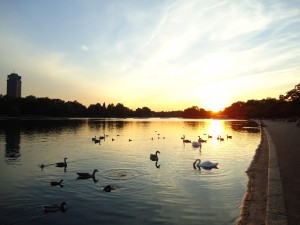
The park also includes many memorials, statues, and historical spots. The first thing you see when you reach Hyde Park from Oxford Street is Speekers Corner. Since the late 19th century, people have spoken there about anything they were interested in preaching. There is a 7/7 memorial and a fountain dedicated to Princess Diana. The most interesting one in the park is the Isis statue. It resembles a crane is meant to inspire people to cherish the wildlife that they have around them. It recognizes the relationship that I previously talked about.
In many ways, Hyde Park incorporates the culture of London into its beauty and nature.
Tags: 2010 David
September 21st, 2010 · No Comments
We have been to our fair share of churches, cathedrals, and other religious buidings. Looking up at the incredible painted ceilings and windows at these cathedrals, a visiting American would typically think, “My church doesn’t look like this”. The churches of London have been constructed by world famous architects for hundreds of years. The role of churches in London differs vastly from the purpose of churches in the United States (this we have discussed several times). The main purpose of these churches is rooted moreso in the Brits deep pride and value in their rich history a bit moreso than the prayers and sermons that are uttered in the buildings.

Westminster Abbey
Since my time spent here I have noticed that the Brits care a lot about, and ruthlessly display their long, inspiring history. I believe that these churches (St. Pauls, Westminster Abbey, etc.) serve as living pieces of history for the Brits moreso than places of worship for that reason. Walking through Westminster Abbey almost seems like your at some sort of Rock N’ Roll hall of fame for famous people’s graves. I can’t think of a better way of preserving and glorifying history than walking through a museum of dead guys with significant roles in the history of London. The elegant layouts and statues where the heroes of London stand frozen in time give places like the Abbey almost a museum-type feeling. I especially felt this way on our tours in the Abbey and St. James, where I felt like we were being ushered from exhibit to exhibit. The basement of St. Paul’s was even undergoing work so that they could put an exhibition on display, not unlike a museum.

St. Paul's Cathedral
Of course, these churches do still hold religious ceremonies; I saw a wedding at St. Pauls one of the days we went there, and there was a moment of silent prayer when we were touring Westminster Abbey. Our tour guides explained at several of the sites about how their regular services proceed as well. These religious observations still seem to be playing second fiddle to the awesome, breathtaking history that the churches hold. I am sure that more people attend tours than services on a daily basis at a place like St. Pauls or Westminster Abbey. Along with the Brits’ pride and dedication to their history, these churches serve as spots that honor the unification of London and its people as a whole. Hell, the entire country had a national religion in the Church of England for many, many years. One country, the majority of which were a member of one religion, and the church for which all these buildings were constructed. Our tour guide at St. Pauls explained how during the Blitz, a chaotic period that made the people of London fear for their lives on a day to day basis, that as long as they could see St. Paul’s church everything would be alright. Quite a deep belief on the part of the people of London. A belief reinforced by their nature of being proud of their past and their knowledge of it. So, while these churches and cathedrals might appear to be some kind of religious museum, they remain some of the most well recognized and inspiring aspects of London.
Photos courtesy of: members.virtualtourist.com, lilacnet.net
Tags: 2010 Benjamin
September 21st, 2010 · 2 Comments
With sunny skies and a temperature of 20 degrees, yesterday was the perfect day to get out of the museums and visit Kew Gardens. To get to the Kew Gardens tube stop, you take the Northern line to Embankment, and transfer to the westbound District line trains terminating at Richmond. The ride from Embankment to Kew Gardens took a little over 30 minutes, so plan to spend at least 2 hours at the gardens to make the trip worthwhile. After leaving the Kew Gardens tube stop, you must take a brisk five minute walk down a tree lined street, to the Victoria gate of the Royal Botanical Gardens.
The entrance fee at the gates is £13.50 for adults, but £11.50 if you bring your student ID. At the entrance, I saw several people showing cards and being allowed quick entrance without buying tickets. Later, when I spoke to a guide I inquired what this card entailed, and the guide explained that many of the denizens of the surrounding area had purchased membership in order to enjoy the privilage of visiting the park for free whenever it was open. Even though the neighborhood by the tube stop was quite scenic and had lots of open public space, it became apparent to me that the ammenities that the park provided made a full membership worthwhile if you lived in the surrounding area.
As you walk down the path from the entrance, you are greeted by the sight of a diverse selection of trees from arround the world, neatly arranged in groves to the sides of the path. Along the way, I spotted what is believed to be the oldest tree in Kew Gardens, a Sweet Chestnut tree thought to have been planted in the early 18th century. The Sweet Chestnut tree is thought to have been introduced from Southern Europe by homesick Romans who were known to use the chestnuts to produce flour and other edibles.
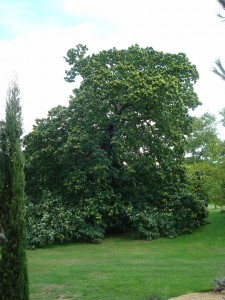
I decided to walk to the southern end of the Gardens, toward the Japanese landscape garden, with a “Chokusi-Mon” replica in the center. Chokusi-Mon means “Gateway to the Imperial Messenger” in Japanese, and this temple was a replica of one in Kyoto.

There was also a peacock just chillin’ to the side of the path, next to a bush! Some of the other visitors, who seeing from their accents were British, passed by and made clicking noises to get the attention of the bird. They were not very sucessful, but it reminded me of Kate Fox’s discussion about how Brits like to talk to pets and animals for as a coping mechanism for their social dis-ease.

Finally, I visited the Princess of Wales Conservatory, which contained several plant selections from several climate zones, including a Tropical Rainforest, Desert, Tropical and Temperate Ferns, and an Orchid room! There were live butterflies in several of the rooms, but I couldn’t take any pictures because I used all of the spare memory on my camera. If you are ever in London again, and want to escape the bustle of the city, go to Kew Gardens!

Tags: 2010 Tyler · Uncategorized
September 21st, 2010 · No Comments
I’ve been trying very hard not to compare London with New York, and failing miserably. But I think that this is one topic on which I may be excused – Broadway vs. West End. As a native New Yorker, and someone fortunate enough to have seen a number of Broadway shows, I must admit to a certain bias. However, almost all of the shows that I have seen in London have been wonderful productions. The Merry Wives of Windsor at Shakespeare’s Globe, though painful due to standing for two hours, was definitely a unique experience. You can’t get quite the same feel in the states – it doesn’t feel as genuine. Les Misérables and 39 Steps were also very well done, offering two of my favorite things – music and comedy. I even enjoyed The Habit of Art, a more serious drama than I am usually partial to. Not only were each of the productions well executed technically, but I thought the actual acting, the conveying of emotion was phenomenal.
However, not every performance I attended left me with the same impression, and I’m afraid that one really bad experience has tipped the scale in Broadway’s favor. I think almost everyone in our program has heard of the great theatre debacle by now. If you haven’t, here’s a quick rundown: Mel, Dan and I went to see a show in the West End. I cannot reveal which show because we all decided that it was just too horrible to mention by name ever again. However, I can describe what was so terribly bad about it. Perhaps what I found most frustrating was that the show had such potential. The plotline allowed for many opportunities of real dance numbers. Instead we got the same exact choreography again and again, song after song. Usually in a musical, dance numbers also have singing. Again we were disappointed. Most, if not all of the songs were played from a soundtrack with the performers occasionally singing some obnoxiously loud misplaced note. And now we discuss the acting. To be fair, they really didn’t have much to work with, but even a high school student could have done a better job of conveying emotion. I suppose there was attempted humor, but the jokes were not funny and even if they had been, the lines were delivered without much enthusiasm.
Tags: 2010 Sarah
September 21st, 2010 · No Comments
As a young American, it is really hard to find a good pub in London. And I’ve tried. We’ve all had the experience of going into a pub and being told that it’s not open, despite the fact that there are still a lot of people sitting at tables, some even being served at that moment. And, no matter how early pubs close in London, 9:42 is not a believable closing time.
Jesse, Emily, and I were discussing why we thought pubs would tell us they close so early. Don’t they want our business? The answer, of course, seems to be dependent on who we are. If we- a crowd of excited, loud Americans- go into an already full pub in Bloomsbury, the bartender doesn’t necessarily want to bother with the hassle. In groups, we can be very noisy, and the fact that sometimes we want to order separately doesn’t seem to help our cause. If just a few of us walk quietly into a relatively empty pub at quarter to 11, they are much more likely to serve us, despite the late hour. Recently the three of us were looking for a pub in the neighborhood, even though it was nearly 11, and The Jack Horner of Tottenham Court seemed to be open. Even though it was late, we had the best service I’ve had at a pub. They were friendly, attentive, and even apologetic when they told us (at 11:17) that they were closing, even though we had already been warned. We even got a “good night” from them, something I have definitely never heard from a bartender at a pub before.
I suppose that different areas have different “pub rules,” if you will. Bartenders in Covent Garden, for example, expect all sorts of rowdy customers at all hours of the night. A pub I went to in Covent Garden, for example, was completely packed at 11 one night, and the clientele made no indication that they were about to leave anytime soon. And the bartenders didn’t really seem to mind. In Bloomsbury, though, where the customers generally seem to be upper-middleclass businessmen and regulars who are all relatively quiet, the bartenders don’t exactly look happy to see us when we walk in.
Since I haven’t seen many people my age in pubs, though, I wonder how much of it is that we are young and how much of it is that we are Americans. I think this would be an interesting theory to test. I suppose, in Norwich, it will be easier to tell if we really are being snubbed for being loud Americans or if it is our age group that is less appealing to the pub staff.
On a slightly different note, I would have to agree with George Orwell when he says that it is “the atmosphere” that really distinguishes pubs. I, for example, much prefer quieter, well-lit pubs (like The Jack Horner), where I can sit down and enjoy a pint rather than the more rowdy, crowded pubs (like The Court, for example), where people seem to be drinking their ales (and shots) as fast as they can. What I will call the “college atmosphere” of crowded, dark pubs is all well and good some of the time, but other times I just want to relax.
Tags: 2010 Jessica
September 21st, 2010 · No Comments
Whenever I see green it makes me so happy. I guess it has a lot to do with the fact that I grew up in really big city, so I didn’t get to see green on a regular basis. In Brooklyn, a park consists of a playground set, and a basketball court. You might get the occasional tennis or handball court, but as far as endless acres of green land…dream on! I would have never expected London to have so much green area being a highly developed, bustling city…but I was so wrong. London is so beautiful, which is another reason why I love it here. There is a balance between man made and nature, and while it is nice to live the city life, it is also necessary to get away sometimes and just take a stroll in the park, and not just Central Park (angry New Yorker), but have a variety of great parks to chose from. Not only are the parks beautiful, they are also so clean and well maintained! You can tell that residents respect the parks here and abide by the rules of sanitation. There are even “dog waste only” rubbish bins scattered around the parks, something that is definitely needed back in the states.

My favorite park would have to be Regents Park. In addition to its endless seas of green, I really loved the Queen’s Rose Garden. I don’t understand why flowers make girls so happy, but they give me a warm fuzzy feeling inside that I can’t explain (LOL). Sarah and I lost all concept of time as we wondered through the garden, mesmerized by roses of all different colors, shapes, and sizes. There was also a pond, and a waterfall, and couples smooching everywhere, which made us gag, but I guess one would say that the garden set the scene for a romantic getaway. Other than the rat that we saw running through the flowerbeds, it was perfect. It was great to see a very diverse crowd enjoying the afternoon in the park. I saw all races, and ages, laying in the grass, playing games, or just strolling along the walkway. I guess enjoying the afternoon in a park, surrounded by green, is something that almost everyone shares in common. If you don’t like parks, then I guess your just weird.

Tags: 2010 Melissa
September 21st, 2010 · 4 Comments
Maybe my perceptions are a bit skewed coming from Southern California – where it has been illegal to smoke in restaurants the longest and anyone who lights up is shot death glares from everyone within a ten-mile radius- but it seems to me that number of people who smoke in London is drastically higher than in the States.
I’ve lost count of the number of times I’ve been walking down the street only to have the person in front or to the side of me exhale their smoke directly into my path. I’ve had cigarette butts almost land on me as a smoker tosses it away multiple times. Again, maybe I’m particularly sensitive to this- not just because I come from California, but because I had severe asthma as a child, still am highly allergic to cigarette smoke, AND my mother spent almost 10 years teaching tobacco and drug education in the California public schools. So, I think it’s fair to say I’m pretty aware of smoking.
I’m making no personal judgements on smokers, but I just don’t understand how it can be so much more rampant here. At first I reasoned that maybe the UK’s tobacco education programs (if they have them at all) aren’t as widespread as they are in the States and California in particular but then I happened to notice the label on a discarded pack of ciggies, which looked a little something like this:
 [Photo: http://www.tobaccoonline.co.uk/images/products/1217200833339AMSobranie-Cocktail-cigarette.png]
[Photo: http://www.tobaccoonline.co.uk/images/products/1217200833339AMSobranie-Cocktail-cigarette.png]
I don’t make a habit of checking cigarette pack warning labels in the US, but I’m pretty sure that our warning labels use much smaller print and read something along the lines of: WARNING- cigarettes have been known to cause cancer and certain birth defects. But, no- the Brits put it right out there in big bold print- SMOKING KILLS. So why does such what seems to be a huge percent of London’s population continue to do it? There is a very weird disconnect here . . .
I actually did some research on this and, according to the London Health Observatory, “About 10 million adults in Great Britain smoke cigarettes – 23% of men and 21% of women” (http://www.lho.org.uk/LHO_Topics/National_Lead_Areas/Smoking.aspx#Smoking). However, data from the 2008 General Lifestyle Survey showed that, compared to other regions of England, London doesn’t actually have that high a percentage of smokers:
“The regions of England with the highest prevalence were the North West, and Yorkshire and the Humber, where 23 to 25 per cent of people were cigarette smokers (similar to the level in Scotland). The prevalence of cigarette smoking was lowest, at 19 per cent, in the East of England and in London”- http://www.statistics.gov.uk/downloads/theme_compendia/GLF08/GLFSmoking&DrinkingAmongAdults2008.pdf
I’m not trying to make a particular point here or offer any words of wisdom for London or Great Britain as a whole- I’m truthfully just amazed at how many people seem to smoke here. Looking at the statistics, though, makes it seem like London isn’t really that much of a smoker’s city.
So, I guess, what I’m asking is, what have been everyone else’s experiences? Am I just uber-sensitive? Are the statistics plain wrong? Maybe a little of both? Whatever the case may be, I really wish Londoners would stop blowing their smoke wherever they please and be a little more conscientious- some of us have delicate lungs! *cough*
Tags: 2010 Elizabeth
September 21st, 2010 · No Comments
Perhaps I should begin by writing about how different they are from what I expected. First of all, London is supposed to be this big hoppin’ city with a fantastic nightlife. Wrong. Almost every pub we tried the first two weeks we were here closes at eleven o’clock – weekends included. When the first bartender told us, I didn’t believe it was true. I thought they were just trying to get rid of the annoying American kids that don’t know how to order a pint. But then I started to realize that everyone in the pub was leaving and it was the same for each of the pubs we visited after that, so it couldn’t be simply a conspiracy against obnoxious students. My next reaction was annoyance and frustration. What kind of city closes at eleven?
I also expected that the music selection would be a little bit different. My assumption was that a British establishment would play British or at least European music. Wrong again. As Mel’s post pointed out, pubs here play mostly American music. During the course of an evening one may hear Justin Timberlake, R. Kelly, Journey, Lady Gaga….and the occasional Beatles song (but let’s face it, we have Americanized the Beatles to the point where we have adopted them as our own). I am really disappointed that I haven’t heard any new songs yet. Has American pop music become a British norm? Hopefully once we get up to Norwich and out of such a touristy area we will encounter a more diverse and authentic British sound.
One of the things we learned from Kate Fox is that pubs are one of those bizarre exception places where British people are allowed to be friendly if they want to. This is perhaps the only one where my expectations have held true. I assumed both from reading Kate Fox and from my own social instincts that although no one would approach me, if I instigated a conversation people would generally respond warmly. My first experiment: the bartenders. Almost every one of them has been friendly. No one has made fun of my accent, or my inability to sort through the ridiculous multitude of coins which any British child of five could handle. My next victims were the actual pub goers, and it seems that the same rules apply. One night at The Court, a couple of us wanted to play pool but we weren’t sure what the etiquette was for queuing or why table seemed to have different dimensions than the ones we are used to back home. The group of British kids that were already playing were happy enough to explain to us that the table is smaller because it wasn’t actually meant for billiards but a different type of game. While we waited for our turn a few of them continued to talk to us providing us with little helpful tips and tidbits of information.
All in all, I’d say that the pubs have been a mixed experience. I think that after I get over the initial shock of early closings, I could really learn to enjoy them.
Tags: 2010 Sarah

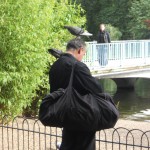


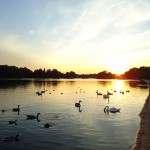
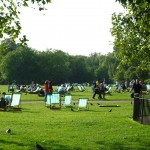









 [Photo: http://www.tobaccoonline.co.uk/images/products/1217200833339AMSobranie-Cocktail-cigarette.png]
[Photo: http://www.tobaccoonline.co.uk/images/products/1217200833339AMSobranie-Cocktail-cigarette.png]